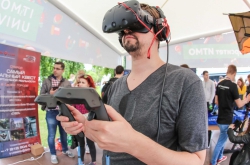Video Assistant Referee (VAR) system
VARs are a common element of hockey, volleyball, and other sports. In the past couple years, they’ve started seeing use in football: for instance, at the Confederations Cup, held in Russia in the summer of 2017. This year, however, marks the first time a VAR system is used at a World Cup. Video replays are used to verify goals and other events, e.g. to make decisions regarding penalties or rule violations. In one example, France won its game against Australia (2:1) due to a penalty that initially went unseen by the referees. Here’s how VAR works: three video assistants observe the game using a number of cameras and relay information to referees via headsets. The head referee, in turn, can trust their call or request a video replay of the incident in question.

VR and 5G
Even though the standards for their operation have not yet been fully developed, 5G internet networks are being tested all around the world. These networks are expected to provide a bandwidth of up to 10 GB/s, which is 100 times more than a 4G network. On June 15, the game between Morocco and Iran was streamed in VR using a 5G network. Special cameras were installed at the stadium in St. Petersburg in order to transmit the signal to Moscow, where fans could use VR headsets to watch the game in real time.
“The main issue for livestreaming events in VR today is how you transmit the data. Since it’s hard to stream 4K video, companies that plan to introduce 5G use VR to show its capability to stream high-definition images. Today, wireless VR works great with Wi-Fi networks; once 5G is introduced, you’ll be able to do the same outside, which should have some interesting effects,” says head of the SIE Video360Production Denis Stolyarov.

EPTS
Electronic Performance and Tracking Systems (EPTS) are capable of tracking a player’s performance on the field. Although the system itself isn’t exactly new, it’s never been employed at such a large-scale event before. The main benefit of EPTS is to the coaches, who can monitor each player’s movements and physiological measurements in real time using a tablet.
Vanishing spray
The vanishing spray was invented by the Brazilian Heine Allemagne in 2000. Two years later, he was granted a patent for his invention, which has since seen widespread use at football events around the world. The spray is used to indicate a spot where the players must stand for a free kick. After a few minutes, the spray disappears, leaving no trace.
Today, spray manufacturers continue to improve on their product by supplying referees with tight-fitting holsters for the cans and making it perform the same in any weather, from hot to freezing.

Adidas’s “smart” ball
Smart devices are no rarity these days, and that extends to football, too. New match balls are made for many major events, and the 2018 World Cup introduced the Adidas Telstar 18, a descendant of the iconic Adidas Telstar introduced in 1970. An NFC chip in the ball lets Android and iPhone owners use their devices to interact with the ball, learn more about it and access a personalized news feed.

Driverless shuttle buses
Fans in Moscow can travel around using the unmanned Shuttle (made by Volgabus and BMG) and Matryoshka (made by Kamaz and NAMI) buses. Volgabus has introduced three different-sized models; the smallest can serve 4 to 6 passengers, while the largest has space for 20 passengers. Eight high-frequency cameras track obstacles such as potholes, pedestrians, poles, etc. while the buses travel at the speed of 15-20 km/h.





